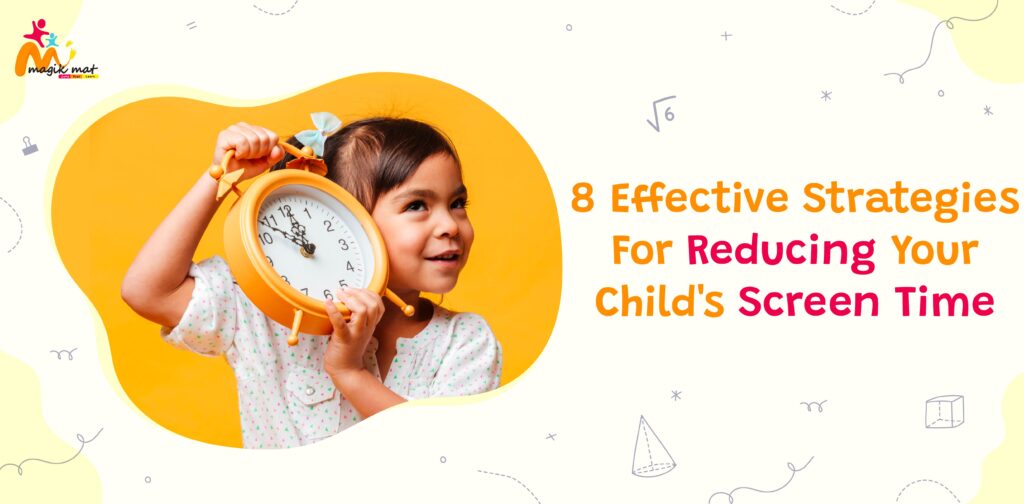Introduction
In today’s digital age, children are growing up surrounded by screens, from smartphones and tablets to computers and televisions. While technology offers countless benefits, excessive screen time can have detrimental effects on a child’s physical and mental well-being. As a parent, finding a balance between embracing technology and ensuring your child engages in other enriching activities is crucial. In this blog, we will explore 8 effective strategies for reducing your child’s screen time.
Why is it important to limit your child’s screen time?
Limiting your child’s screen time is vital for their overall well-being. Excessive screen use can lead to physical health issues such as sedentary behaviour, disrupted sleep patterns, and obesity. It also affects social development by impeding face-to-face interactions and hindering the development of interpersonal skills. Academic performance may suffer due to disrupted sleep and decreased concentration. Moreover, excessive screen exposure has been linked to mental health issues like increased anxiety and decreased attention spans. Limiting screen time encourages a more balanced lifestyle that includes physical activities, social interactions, and creative pursuits, contributing to a child’s holistic development and fostering healthier family dynamics.
Effective Strategies for Reducing Your Child’s Screen Time
1.Set Clear Boundaries: Establishing clear and consistent rules regarding screen time is the first step. Create a daily or weekly schedule outlining when screens are allowed and when they are not. Be firm but flexible, allowing for special occasions while maintaining a routine that prioritizes other activities.
2.Lead by Example: Children often mimic their parents’ behaviour. If they see you glued to your phone or spending hours in front of the TV, they are likely to follow suit. Make a conscious effort to model a healthy relationship with screens, demonstrating that there are times for technology and times for other activities.
3.Create Screen-Free Zones: Designate specific areas in your home where screens are not allowed, such as the dinner table or bedrooms. This helps create a separation between screen time and personal interactions, encouraging your child to engage in face-to-face communication and develop interpersonal skills.
4.Encourage Outdoor Activities: Promote physical activity by encouraging your child to spend more time outdoors. Whether it’s playing sports, riding bikes, or simply exploring nature, outdoor activities not only reduce screen time but also contribute to overall well-being.
5.Provide Alternative Activities: Offer a variety of engaging and stimulating alternatives to screen time. Encourage hobbies such as reading, drawing, playing musical instruments, or engaging in board games. By providing appealing alternatives, your child is more likely to willingly step away from screens.
6.Use Screen Time Wisely: If screens are an inevitable part of your child’s routine, ensure that the content is educational and age appropriate. Select games, apps, and shows that promote learning and creativity. Set a timer to limit screen time and use parental controls to monitor and restrict access to inappropriate content.
7.Establish Tech-Free Rituals: Create daily rituals that do not involve screens. This could include family meals, bedtime stories, or weekend outings. By incorporating these tech-free moments into your routine, you reinforce the importance of real-world connections and shared experiences.
8.Communicate Openly: Talk to your child about the importance of a balanced lifestyle and the potential drawbacks of excessive screen time. Help them understand the value of spending time with family, pursuing hobbies, and maintaining a healthy mind and body. Engage in open conversations to address any concerns or challenges they may be facing.
How Does the Magik Mat Contribute to Limiting a Child’s Screen Time While Still Incorporating Technology?
Magik Mat offers a unique solution by promoting a learn-and-play concept that seamlessly integrates technology into a child’s routine. It focuses on cognitive skills and physical activity, providing a balance between screen time and real-world engagement. With various educational games based on math and English, children can learn while actively playing on the mat. The incorporation of physical activity, such as jumping, not only makes the learning experience dynamic and enjoyable but also addresses concerns related to sedentary behaviour. In essence, Magik Mat encourages a healthy relationship with technology by offering an interactive and educational platform that supports a child’s overall development.
Conclusion
The decision to limit your child’s screen time is not just a matter of imposing rules; it’s a crucial investment in their well-being and future. While technology undoubtedly brings numerous benefits, the potential risks associated with unrestricted screen use cannot be overlooked. As a parent, taking a proactive stance in managing your child’s screen time sends a powerful message about the values you prioritize health, genuine human connections, and the development of well-rounded individuals. By fostering a balanced lifestyle that includes a variety of activities beyond screens, you not only mitigate potential negative effects but also actively contribute to your child’s physical, mental, and emotional growth. It’s about equipping them with the skills and habits that will serve them well throughout life, setting the foundation for a future where technology complements, rather than dictates, their journey. Ultimately, the effort to balanced screen time is an investment in a healthier, more connected, and fulfilling future for your child.





